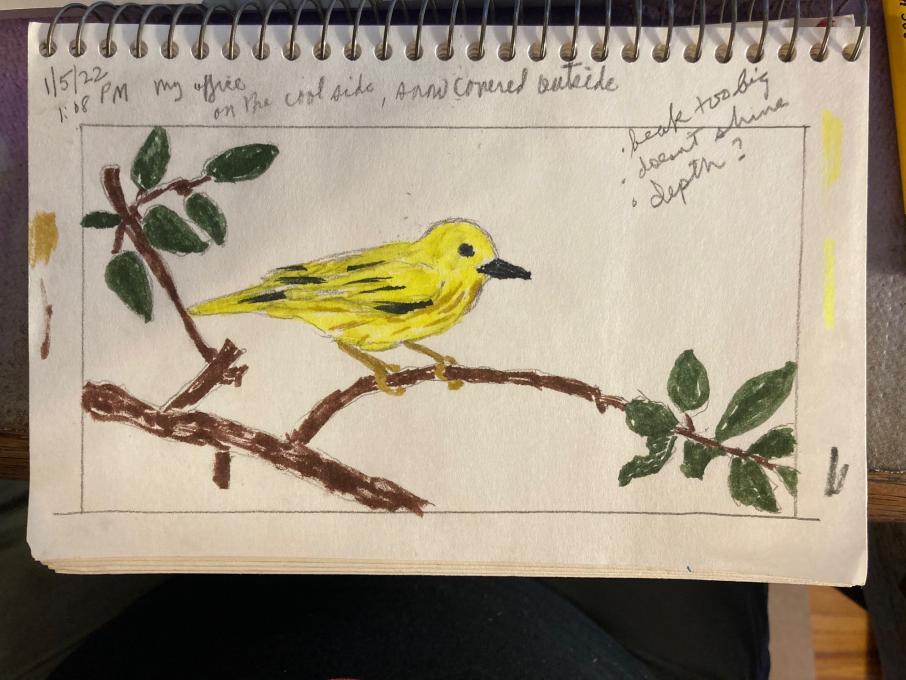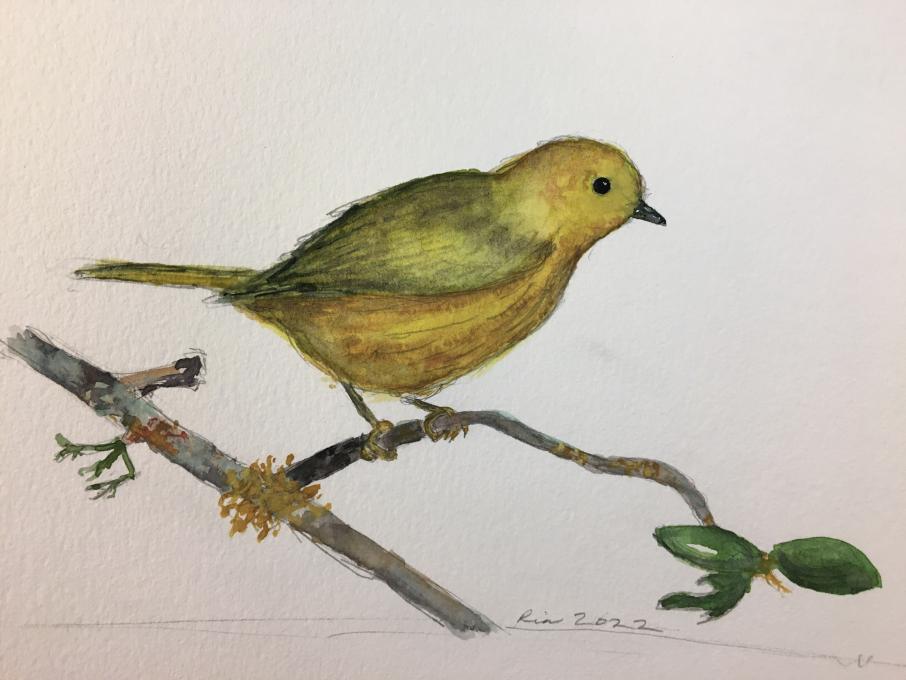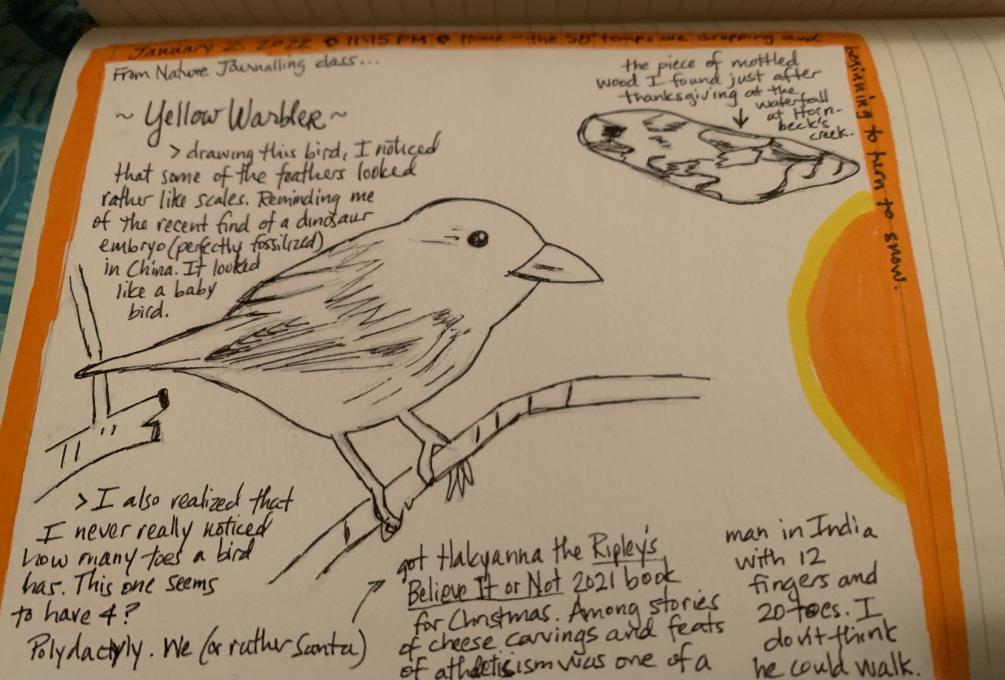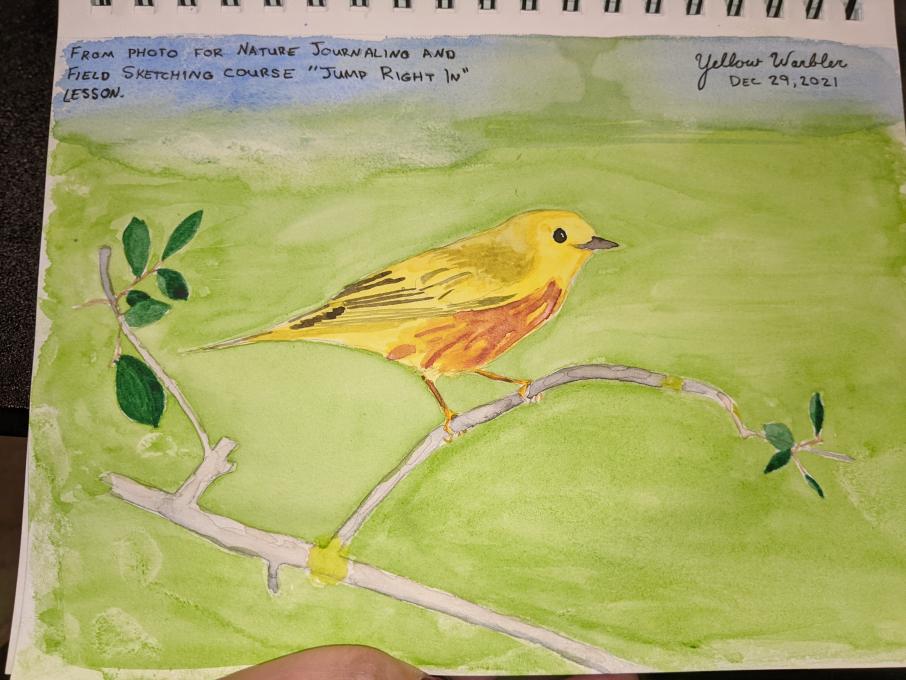The Cornell Lab Bird Academy › Discussion Groups › Nature Journaling and Field Sketching › Jump Right in!
-
I usually draw from photo for inspiration but not for exact likeness, close but not exact. I want to get better at drawing live examples . Might still take photo for color reference and the patterns on subject till I get better at drawing from live forms. Hoping to sharpen drawing skills from live nature forms first then develop better water color painting and notes and super simple color. I am not fast at drawing from live objects so this is going to be a challenge for me, but I look forward to it. Joan Stanton
-
 Well , here is my first horrible attempt with pure water color. I normally paint with gouache or water color pencil. Hoping to learn more techniques from this course. Joan Stanton
Well , here is my first horrible attempt with pure water color. I normally paint with gouache or water color pencil. Hoping to learn more techniques from this course. Joan Stanton
-
It was fun to not think or add judgement to my first drawing - I'm new so it can be bad. It didn't end up looking terrible and I found that when I took the pressure off I also focused more on what the bird was perched on. I missed the moss and lichen but adding the leaves made the whole experience for me. Lil yellow came out looking as happy as I am right now!

-
Drawing is something out of my comfort zone, but hope to improve upon during this course. It was good to be able to refer back to the photo when I was drawing. The branches and leaves were somewhat easy to draw. But getting the proportions of all items in the photo was a bit challenging along with drawing the warbler's head. My drawing is not ready for prime time showing....maybe next time.
-

-
I enjoyed drawing the picture. It is certainly apparent that drawing it really make me notice lots of details.

-
I found this sketch very difficult (challenging?), especially getting the proper proportions and placement of the bill and eye. Obviously, I still have a lot to learn about drawing feet. The textures and colors of the branch, and particularly the lichen, were a challenge.
 The bill is one of the key features distinguishing warblers, so I struggled to get the size and shape of the bill right. I'd draw it too large, then erase it and draw it again but this time too short, then again too large, then again too short. I drew 5 or 6 iterations of the bill and I'm still not sure it's correct.
This is my first attempt at seriously using colored pencils. I found it both satisfying and frustrating. It was satisfying to be able to add a bit of color to my sketch and it was easy to control where the color went, but it was frustrating in that all the colors appeared very pale and lacked vibrancy. I used colored pencils that I had on hand from a prior effort with "adult coloring books" and I was frustrated by my limited palette and inability to blend colors.
I look forward to learning to use and mix watercolors and hopefully get more vibrant colors and a wider range of shades and hues.
The bill is one of the key features distinguishing warblers, so I struggled to get the size and shape of the bill right. I'd draw it too large, then erase it and draw it again but this time too short, then again too large, then again too short. I drew 5 or 6 iterations of the bill and I'm still not sure it's correct.
This is my first attempt at seriously using colored pencils. I found it both satisfying and frustrating. It was satisfying to be able to add a bit of color to my sketch and it was easy to control where the color went, but it was frustrating in that all the colors appeared very pale and lacked vibrancy. I used colored pencils that I had on hand from a prior effort with "adult coloring books" and I was frustrated by my limited palette and inability to blend colors.
I look forward to learning to use and mix watercolors and hopefully get more vibrant colors and a wider range of shades and hues. -
1. I was, at first, afraid...anxious. I wanted to do well, but I was afraid of creating something terrible here at the beginning. Patience came easily once I started drawing. Attention and forgetting time are natural to me. Getting the angles and attitudes correct was challenging. My warbler's head is still a bit too tall. Maybe more round than oval? Getting the forward-lean sleekness of the bird was difficult. 2. I definitely noticed new things like the moss at the base of the branch junction the bird is perched on. This and the bites out of many of the leaves (insect bites, I assume?) were things I didn't see until I attempted to draw them. Also, the knobbiness of the branch, the light and dark sides of individual leaves, the amount of black in the bird's tail feathers...all of these were details I didn't see in this picture until I attempted to draw the picture. For a difference this would make, I think this level of detail would help my ability to identify similar birds. Also, even more than simply identification, the appreciation of a bird's (or a branches) beauty grows with the attention I dedicate to it. I've noticed this with the birds that regularly return to my feeder. I never realized how formal and sleek chickadees were until I observed their tail feather patterns day by day. Similarly, the intensity of a red breasted nuthatch when it fights alone for its spot on the feeder formerly occupied by four chickadees than pauses curling it's body out to stare down any potential combatants.
 I also included my 9-year-old son's drawing. He saw what I was doing and asked to sit and join me. I've wanted to get both my boys more into birding as I fall more in love with it, and this was a great step in that direction. For him:
1. It looked pretty hard, but everything was actually easier than I thought.
2. Probably the details on the leaves and how there were more than one in some places that I thought was just one big one. Now I know that some hard drawings you have to look at pictures and you could get pretty good at it.
I also included my 9-year-old son's drawing. He saw what I was doing and asked to sit and join me. I've wanted to get both my boys more into birding as I fall more in love with it, and this was a great step in that direction. For him:
1. It looked pretty hard, but everything was actually easier than I thought.
2. Probably the details on the leaves and how there were more than one in some places that I thought was just one big one. Now I know that some hard drawings you have to look at pictures and you could get pretty good at it.

-

-
 I enjoyed interpreting the little textures and values of the lichen and moss on the branch. Drawing allows you to remember things more vividly than a photograph does.
I enjoyed interpreting the little textures and values of the lichen and moss on the branch. Drawing allows you to remember things more vividly than a photograph does. -

-
I enjoyed the process of drawing the photo. The instruction said to draw following Liz' instruction but I didn't find this piece. From the comments and general feel, I assumed we could do as little or as much as we wanted. I used pencil sketching and played with the watercolour box. It was interesting looking at the bird to see that there was some shading that almost needed a grey colour. I chose not to mix colours but go quickly with what I had. Really fun!

-
I have to say the drawing process was super fun!
-
My water color soaked up the pen and made my drawing look dirty. :(
-
l

-

-
I wasn't sure how long to spend drawing it. If it was in the field I suppose it would be a quick gesture drawing depending on how long the bird could stay still. The advantage of the photo would be adding more detail.
-
I was hesitant to start and then pushed myself to rush right in & ended up starting too high on the page so the top of the bird's head is cut off. But once i realized that i relaxed about getting it 'right' this first time. I found myself drawn (pun intended) to the branches in leaves, as a result, zeroing in on the bird's feet, the lichen, leaves & shadowing, which i might not have really noticed if not trying to draw the picture. So i think that drawing in nature journaling leads to looking much more closely at things like beak & wing structures, claws around branches, etc., & could produce richer connections with the subject and so possibly stronger memories of the experience than just taking a photo. . .
-
i felt like i was outside looking at a real bird. I realized that there were tiny strikes of dark yellow on the underside of the belly!
-

-
 If this turns out to be a double submission, please excuse! I found that I can focus on the topic and ignore extraneous details, but I had to work on it, since everything in the photo was clear and detailed. This gave me an accurate portrayal of the bird, and I was able to concentrate on the details in a way that I wouldn't have been able to if I was doing this while watching it. Photos provide a good resource to go to when, after an observation outside, I want to go back and check details on what I've captured in drawing. On a technical note, I was concerned how I was going to show the various shades and tones of yellow, and scoured my pencil box for the "right" color to use. I finally landed on using one color, and found that my shading with a graphite pencil provided the shading I was looking for. A good lesson learned!
If this turns out to be a double submission, please excuse! I found that I can focus on the topic and ignore extraneous details, but I had to work on it, since everything in the photo was clear and detailed. This gave me an accurate portrayal of the bird, and I was able to concentrate on the details in a way that I wouldn't have been able to if I was doing this while watching it. Photos provide a good resource to go to when, after an observation outside, I want to go back and check details on what I've captured in drawing. On a technical note, I was concerned how I was going to show the various shades and tones of yellow, and scoured my pencil box for the "right" color to use. I finally landed on using one color, and found that my shading with a graphite pencil provided the shading I was looking for. A good lesson learned! -
I I know the bird and so was negotiating between what I saw in the photo and what I know about the bird, its habits, etc. That was interesting! I found myself quite interested in the branch and the leaves...a fun exercise! Similarly to taking photos, finding "the focus" of the shot is problematic for me. I see a bird and it looks awesome and so I get my camera ready and once I am looking at the viewfinder I realize the berries to the side of the bird are so striking and the marsh behind it so alive... need to reflect on this longer~

-
The photo was nice for reasons many others have mentioned: static image, ability to zoom in, etc. I did find it difficult to capture the essence of the warbler and got caught in the liminal space between quick sketch and detail. I think you can see my indecision in this drawing, especially in the bird itself... I'm looking forward to feeling more natural with the process so my hesitations stay out of my images and I can accurately reflect my subjects personality and being :)

-
This was fun! I definitely noticed things that I might not have if just taking a photo—like the way some of the feathers looked like scales. Which prompted all kinds of associations.

-
One of the unexpected benefits of working from a photo was the ability to zoom in to investigate the details. I'm looking forward to working on my proportions and watercoloring. Both were very challenging.

Read More:
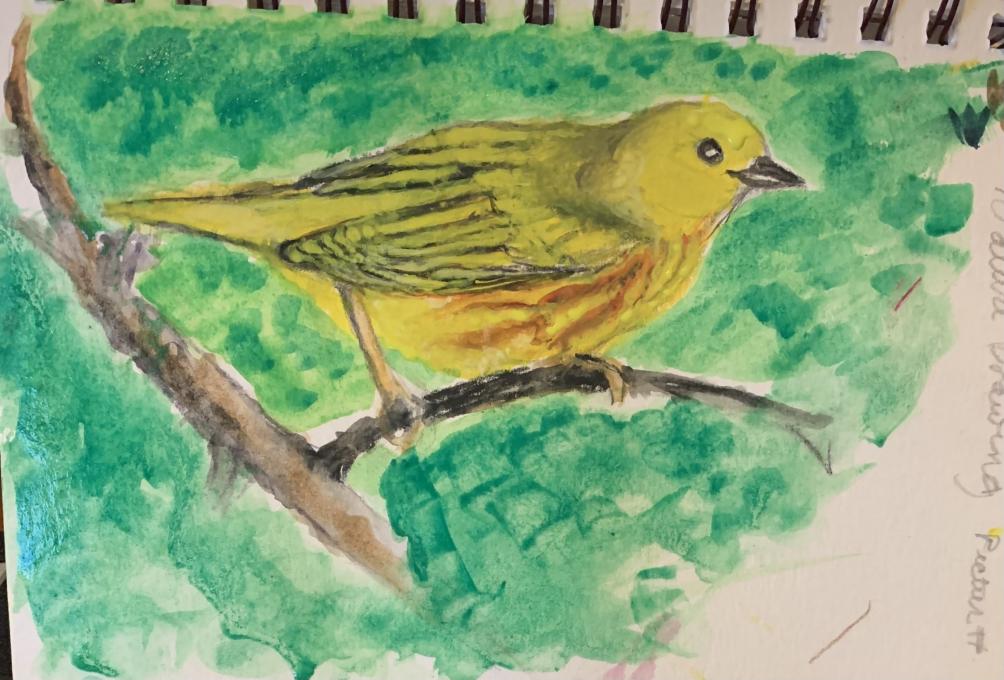 Well , here is my first horrible attempt with pure water color. I normally paint with gouache or water color pencil. Hoping to learn more techniques from this course. Joan Stanton
Well , here is my first horrible attempt with pure water color. I normally paint with gouache or water color pencil. Hoping to learn more techniques from this course. Joan Stanton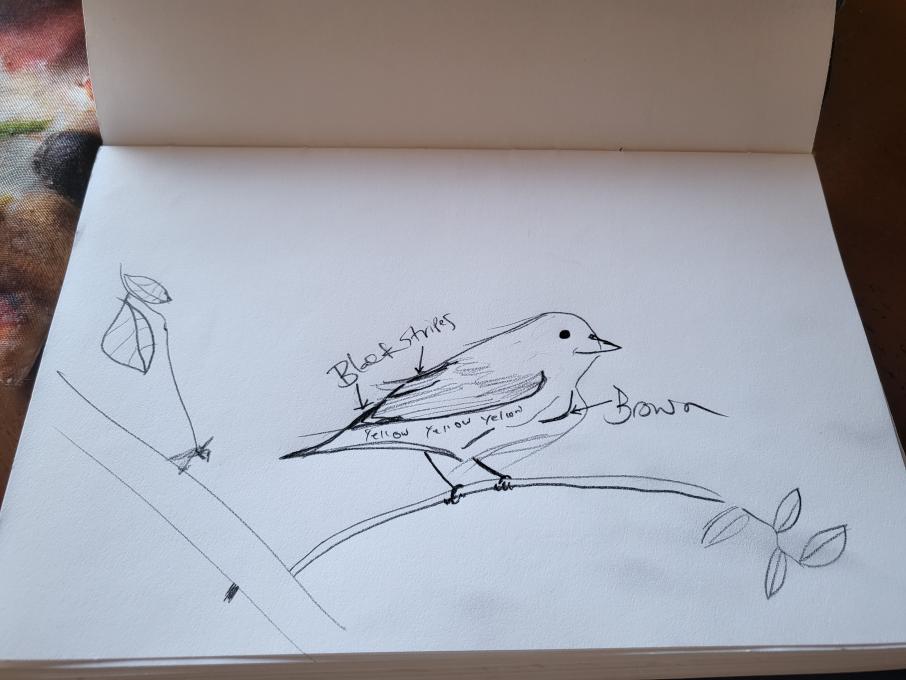
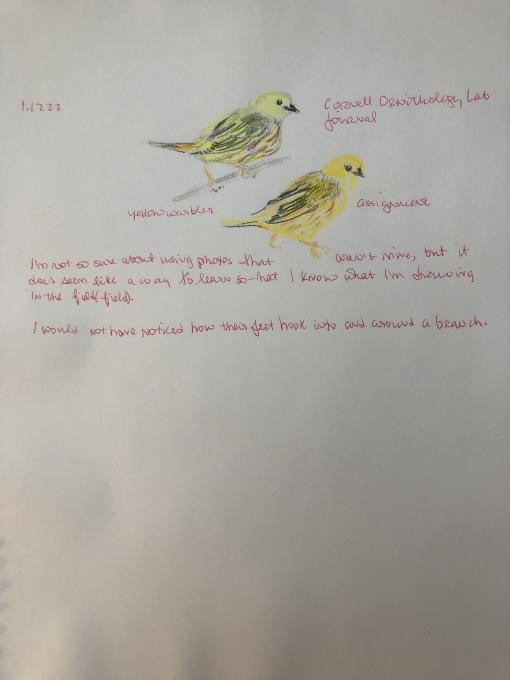
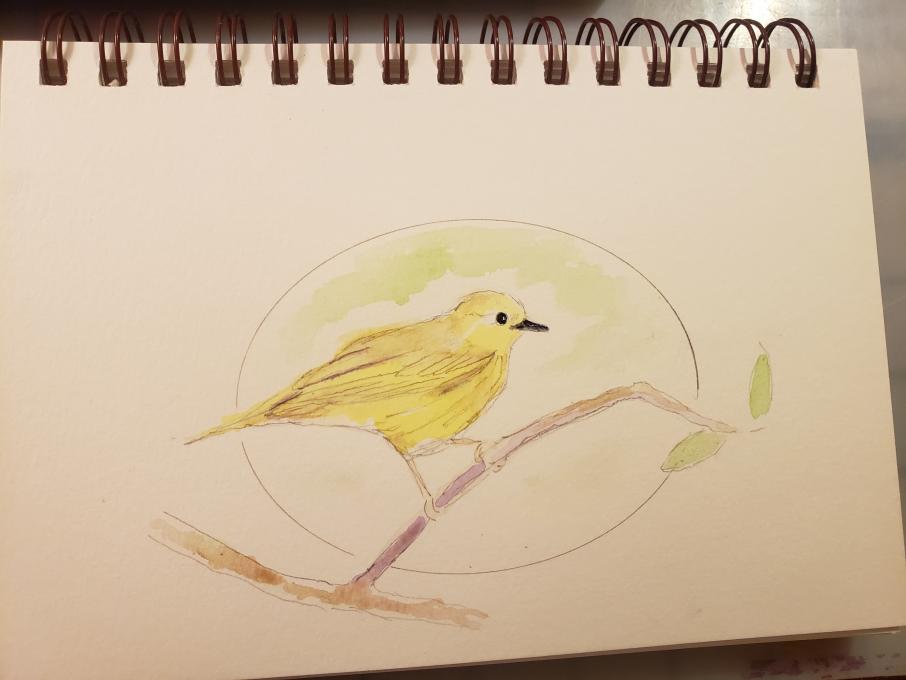
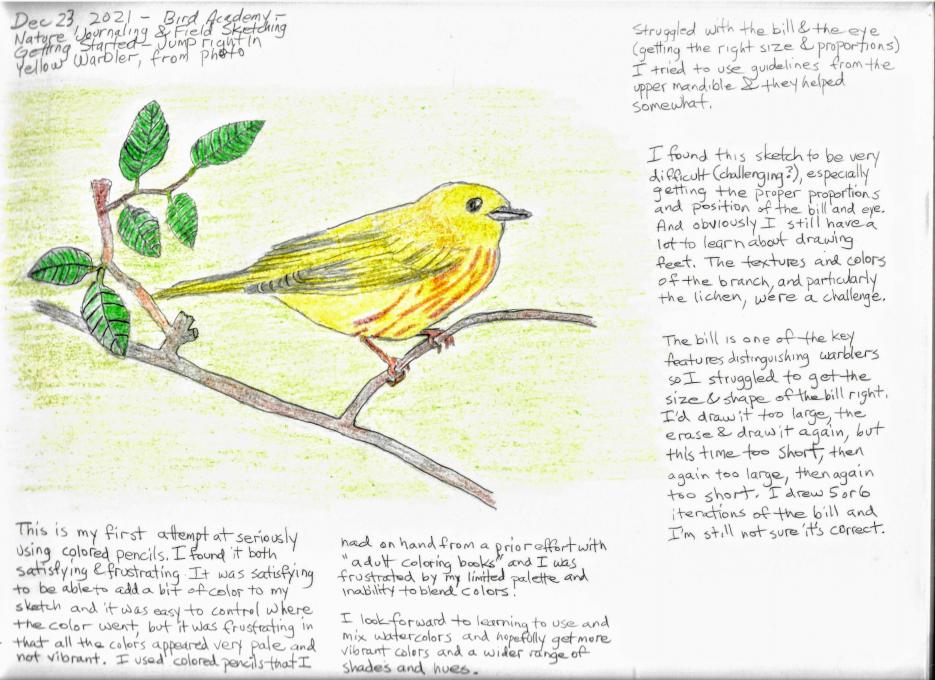 The bill is one of the key features distinguishing warblers, so I struggled to get the size and shape of the bill right. I'd draw it too large, then erase it and draw it again but this time too short, then again too large, then again too short. I drew 5 or 6 iterations of the bill and I'm still not sure it's correct.
This is my first attempt at seriously using colored pencils. I found it both satisfying and frustrating. It was satisfying to be able to add a bit of color to my sketch and it was easy to control where the color went, but it was frustrating in that all the colors appeared very pale and lacked vibrancy. I used colored pencils that I had on hand from a prior effort with "adult coloring books" and I was frustrated by my limited palette and inability to blend colors.
I look forward to learning to use and mix watercolors and hopefully get more vibrant colors and a wider range of shades and hues.
The bill is one of the key features distinguishing warblers, so I struggled to get the size and shape of the bill right. I'd draw it too large, then erase it and draw it again but this time too short, then again too large, then again too short. I drew 5 or 6 iterations of the bill and I'm still not sure it's correct.
This is my first attempt at seriously using colored pencils. I found it both satisfying and frustrating. It was satisfying to be able to add a bit of color to my sketch and it was easy to control where the color went, but it was frustrating in that all the colors appeared very pale and lacked vibrancy. I used colored pencils that I had on hand from a prior effort with "adult coloring books" and I was frustrated by my limited palette and inability to blend colors.
I look forward to learning to use and mix watercolors and hopefully get more vibrant colors and a wider range of shades and hues. 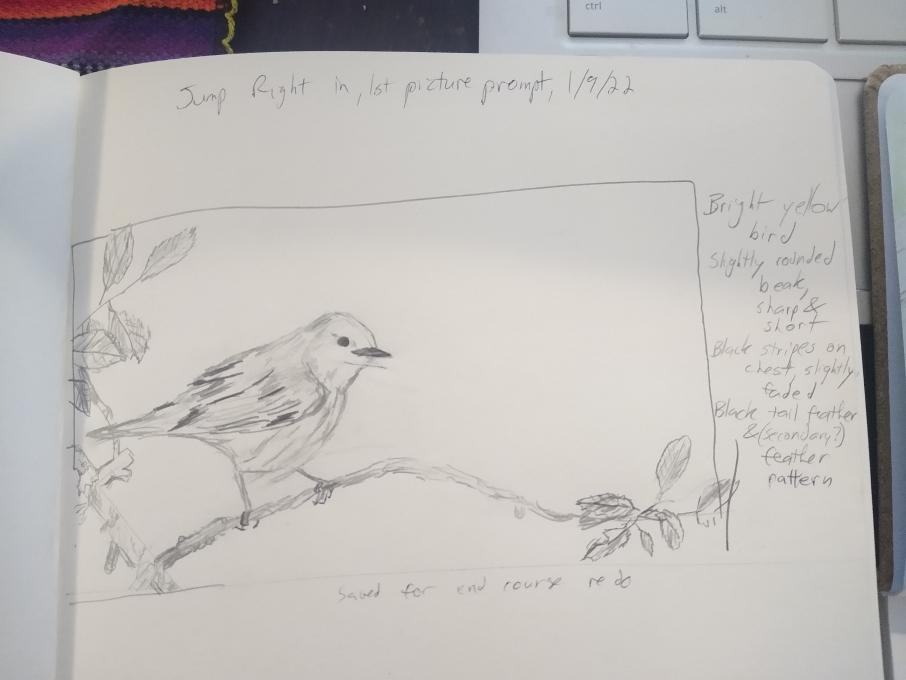 I also included my 9-year-old son's drawing. He saw what I was doing and asked to sit and join me. I've wanted to get both my boys more into birding as I fall more in love with it, and this was a great step in that direction. For him:
1. It looked pretty hard, but everything was actually easier than I thought.
2. Probably the details on the leaves and how there were more than one in some places that I thought was just one big one. Now I know that some hard drawings you have to look at pictures and you could get pretty good at it.
I also included my 9-year-old son's drawing. He saw what I was doing and asked to sit and join me. I've wanted to get both my boys more into birding as I fall more in love with it, and this was a great step in that direction. For him:
1. It looked pretty hard, but everything was actually easier than I thought.
2. Probably the details on the leaves and how there were more than one in some places that I thought was just one big one. Now I know that some hard drawings you have to look at pictures and you could get pretty good at it.
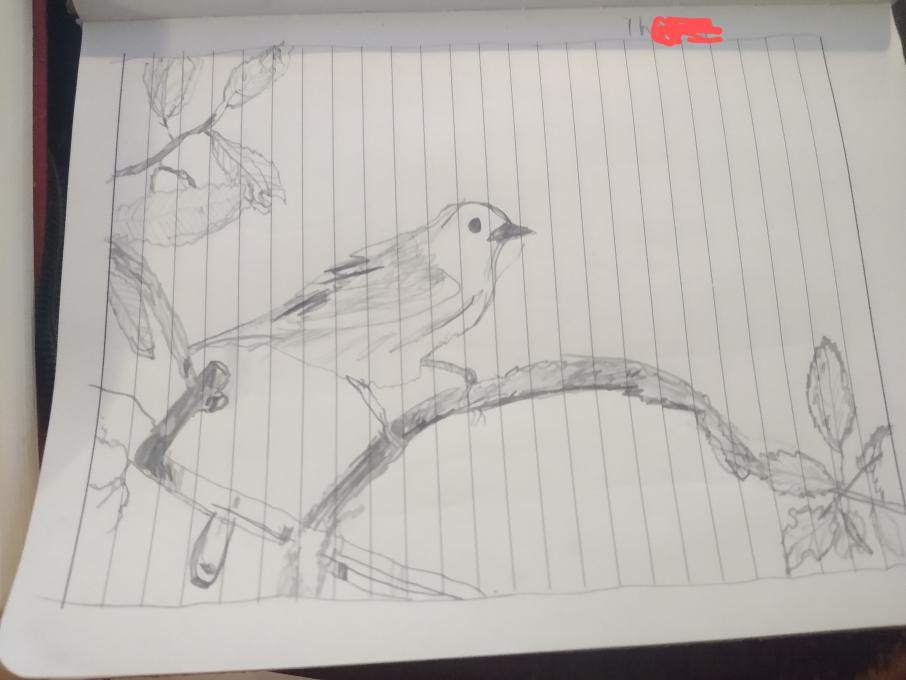
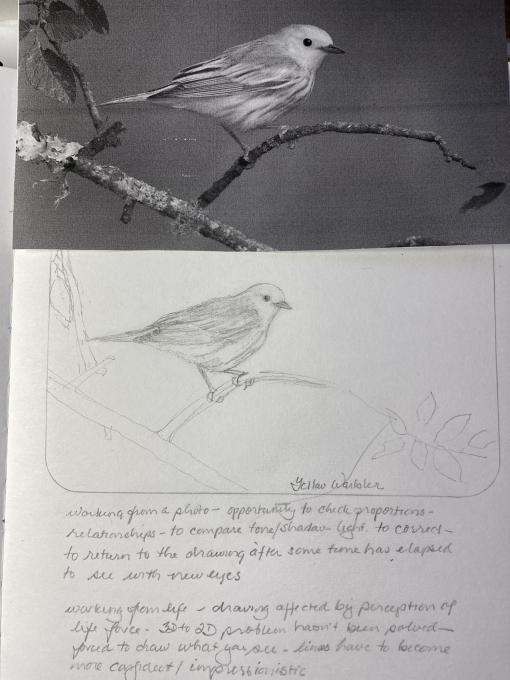
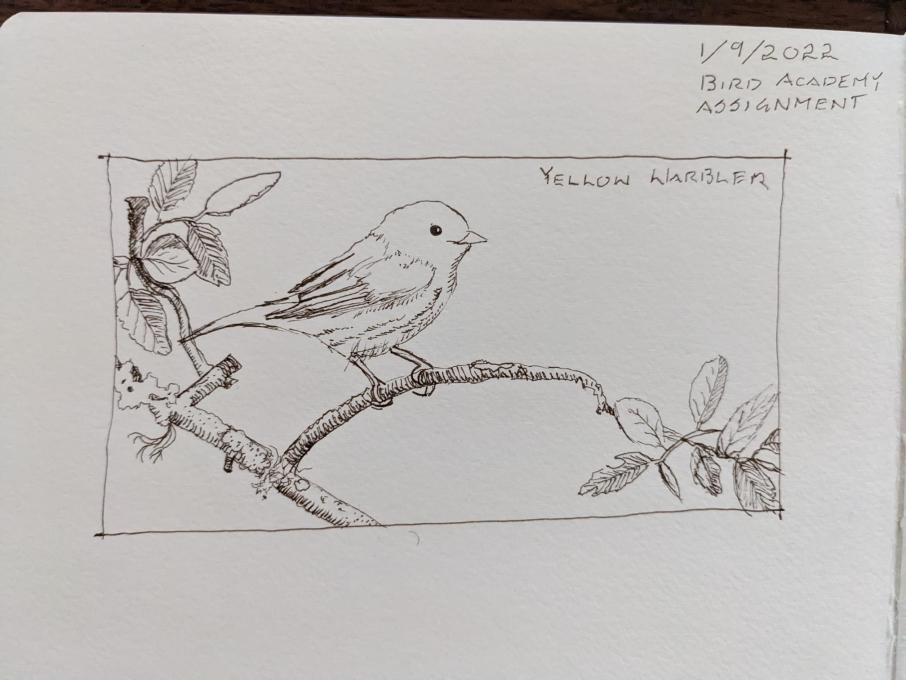 I enjoyed interpreting the little textures and values of the lichen and moss on the branch. Drawing allows you to remember things more vividly than a photograph does.
I enjoyed interpreting the little textures and values of the lichen and moss on the branch. Drawing allows you to remember things more vividly than a photograph does. 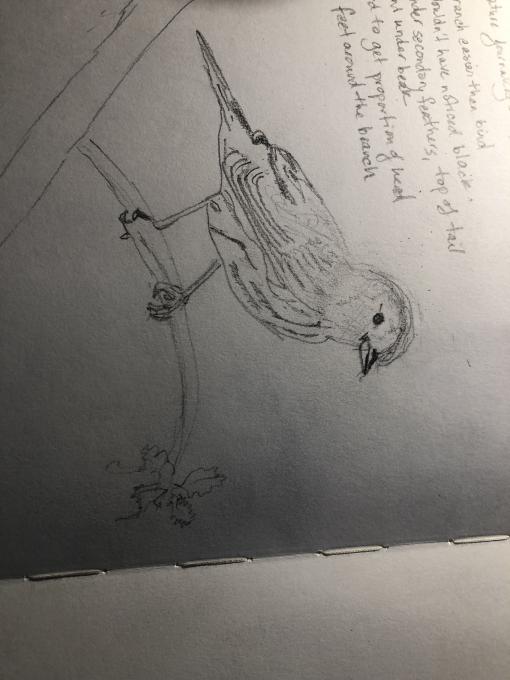
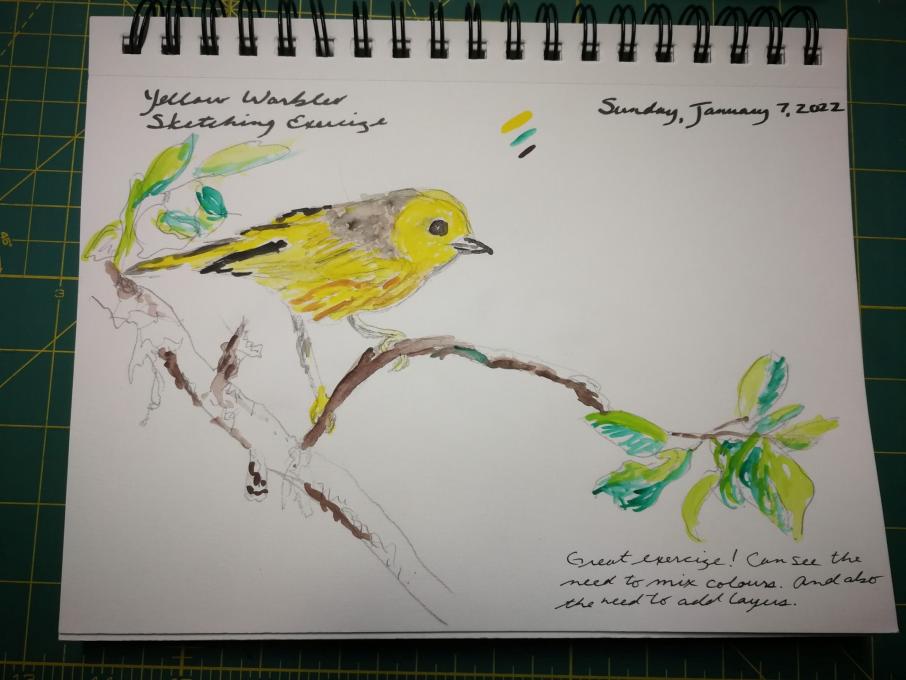
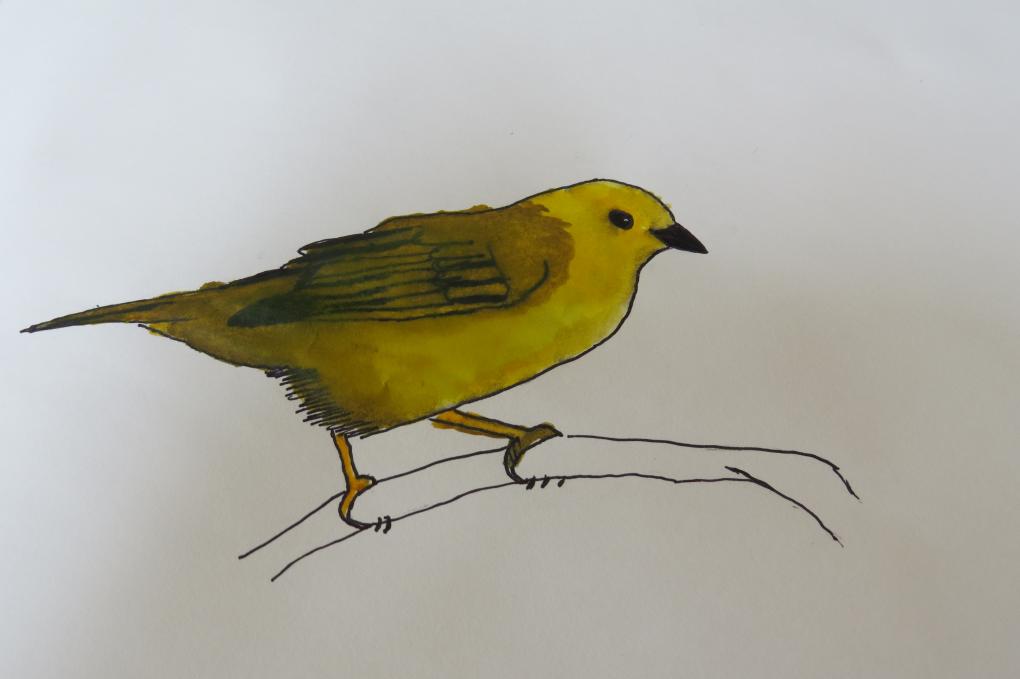
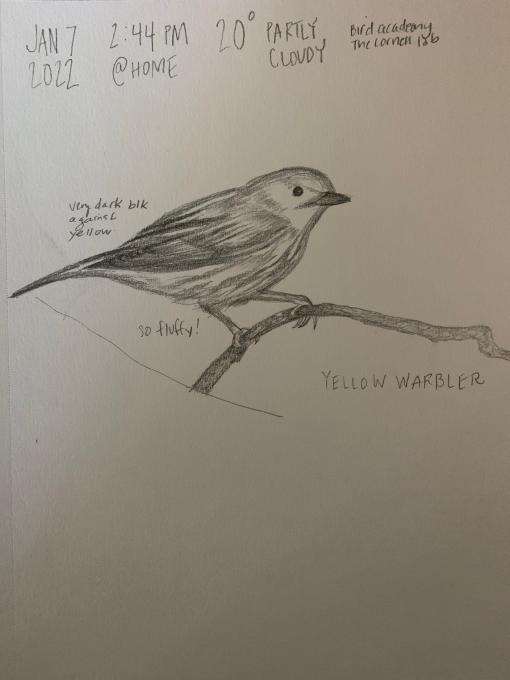
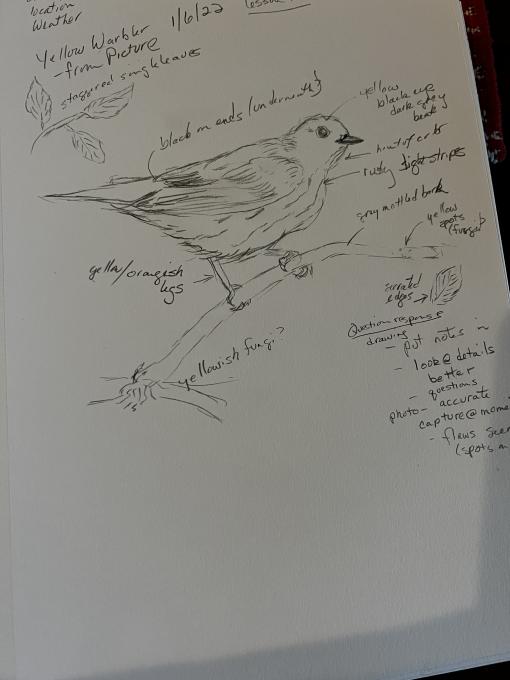
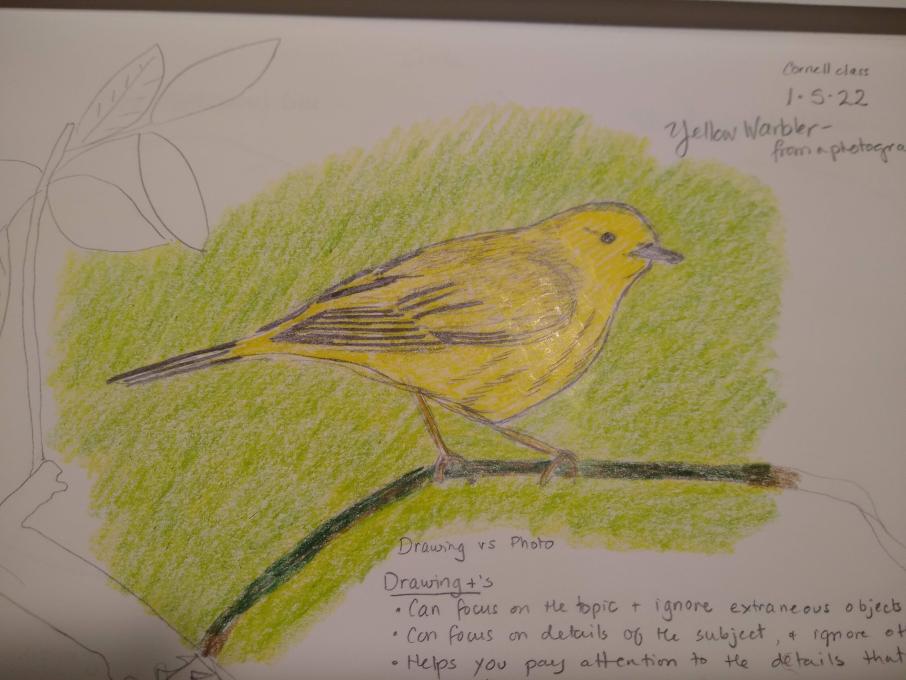 If this turns out to be a double submission, please excuse! I found that I can focus on the topic and ignore extraneous details, but I had to work on it, since everything in the photo was clear and detailed. This gave me an accurate portrayal of the bird, and I was able to concentrate on the details in a way that I wouldn't have been able to if I was doing this while watching it. Photos provide a good resource to go to when, after an observation outside, I want to go back and check details on what I've captured in drawing. On a technical note, I was concerned how I was going to show the various shades and tones of yellow, and scoured my pencil box for the "right" color to use. I finally landed on using one color, and found that my shading with a graphite pencil provided the shading I was looking for. A good lesson learned!
If this turns out to be a double submission, please excuse! I found that I can focus on the topic and ignore extraneous details, but I had to work on it, since everything in the photo was clear and detailed. This gave me an accurate portrayal of the bird, and I was able to concentrate on the details in a way that I wouldn't have been able to if I was doing this while watching it. Photos provide a good resource to go to when, after an observation outside, I want to go back and check details on what I've captured in drawing. On a technical note, I was concerned how I was going to show the various shades and tones of yellow, and scoured my pencil box for the "right" color to use. I finally landed on using one color, and found that my shading with a graphite pencil provided the shading I was looking for. A good lesson learned! 